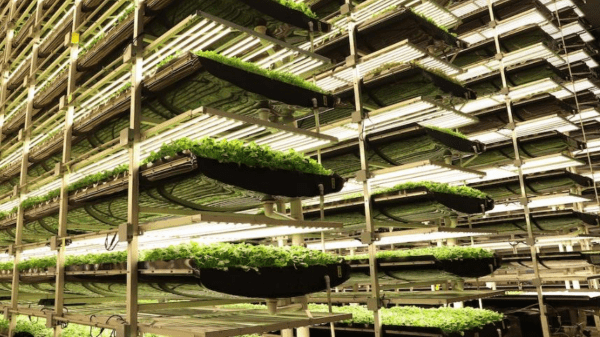Courtesy Aerofarms
This industry segment is all very promising, but how far can vertical farming go?
Mike Zelkind, CEO of 80 Acres Farms, Hamilton, OH, says there’s a critical need to find more efficient ways to feed humanity in a sustainable, scalable manner.
While traditionally grown produce can travel a thousand or more miles between farm and supermarket, he argues that vertical farm-produced items are always market fresh.
“Our simplified supply chain closes the gap between grower and grocer,” he insists. “It’s less vulnerable to extreme weather, natural disasters, and other disruptive events.
“Vertical farming is a proven way to grow consistent, high-quality produce year-round, anywhere,” Zelkind states. “Be that in the heart of a city or in the desert, we can deliver the same results.”
“It’s no surprise business leaders, retailers, and entrepreneurs are becoming interested,” he continues, “and as vertical farms like ours continue to grow, the proposition will become even more interesting.”
Katie Seawell, chief commercial officer for Bowery Farming, Inc., a New York City-based startup, says vertical farming offers a suite of benefits for a world with a growing population.
“In the next 30 years, we’re going to have to double our food supply with fewer resources and more volatility. We think indoor vertical farming is uniquely suited to play a meaningful role because of how protected the produce is: germination, growing, processing, packaging, and distribution is all handled within the vertical farm.
“We’re hugely efficient with space and can grow on nonarable land, while there are real advantages on the water front,” she adds.
“We’re an industry in its infancy, but by moving into new produce areas, there are billions of dollars of market opportunity that vertical farming can play in.”
This is an excerpt from the Applied Technology feature in the March/April 2022 issue of Produce Blueprints Magazine. Click here to read the whole issue.
This industry segment is all very promising, but how far can vertical farming go?
Mike Zelkind, CEO of 80 Acres Farms, Hamilton, OH, says there’s a critical need to find more efficient ways to feed humanity in a sustainable, scalable manner.
While traditionally grown produce can travel a thousand or more miles between farm and supermarket, he argues that vertical farm-produced items are always market fresh.
“Our simplified supply chain closes the gap between grower and grocer,” he insists. “It’s less vulnerable to extreme weather, natural disasters, and other disruptive events.
“Vertical farming is a proven way to grow consistent, high-quality produce year-round, anywhere,” Zelkind states. “Be that in the heart of a city or in the desert, we can deliver the same results.”
“It’s no surprise business leaders, retailers, and entrepreneurs are becoming interested,” he continues, “and as vertical farms like ours continue to grow, the proposition will become even more interesting.”
Katie Seawell, chief commercial officer for Bowery Farming, Inc., a New York City-based startup, says vertical farming offers a suite of benefits for a world with a growing population.
“In the next 30 years, we’re going to have to double our food supply with fewer resources and more volatility. We think indoor vertical farming is uniquely suited to play a meaningful role because of how protected the produce is: germination, growing, processing, packaging, and distribution is all handled within the vertical farm.
“We’re hugely efficient with space and can grow on nonarable land, while there are real advantages on the water front,” she adds.
“We’re an industry in its infancy, but by moving into new produce areas, there are billions of dollars of market opportunity that vertical farming can play in.”
This is an excerpt from the Applied Technology feature in the March/April 2022 issue of Produce Blueprints Magazine. Click here to read the whole issue.



